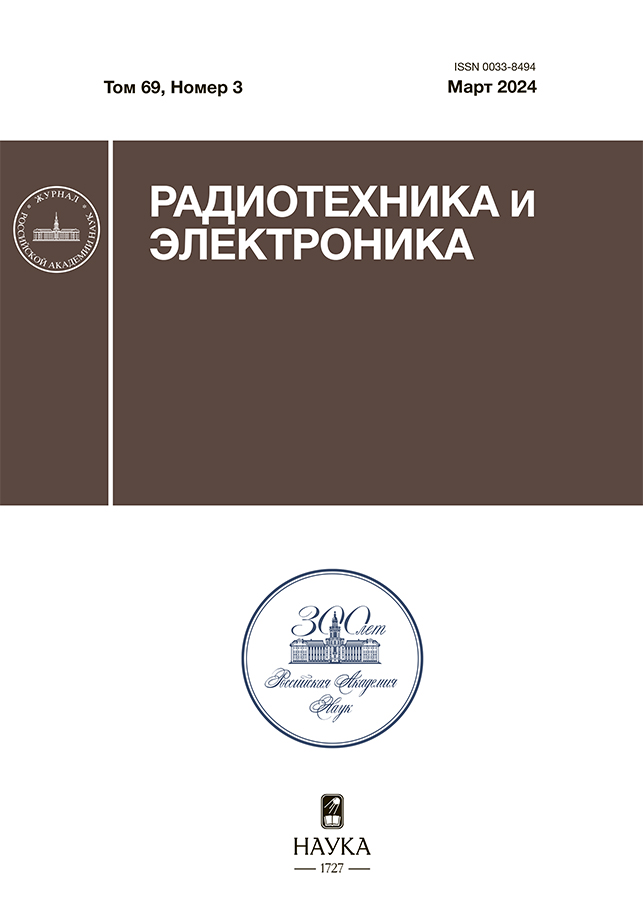Electromagnetic fields transformation in UWB infinite antenna arrays in the cluster excitation mode
- Autores: Bankov S.E.1, Duplenkova M.D.1
-
Afiliações:
- Kotelnikov Institute or Radioengineering and Electronics RAS
- Edição: Volume 69, Nº 3 (2024)
- Páginas: 207-216
- Seção: АНТЕННО-ФИДЕРНЫЕ СИСТЕМЫ
- URL: https://kazanmedjournal.ru/0033-8494/article/view/650696
- DOI: https://doi.org/10.31857/S0033849424030011
- EDN: https://elibrary.ru/JVRVFC
- ID: 650696
Citar
Texto integral
Resumo
Infinite ultra-wideband (UWB) arrays of TEM horns and Vivaldi antennas were considered. At the first stage we used an array model in the quasi-periodic excitation mode in the form of a Floquet channel. It was implemented in the HFSS electromagnetic modeling system. At the second stage the array parameters in the cluster excitation mode were determined using the calculated scattering matrix of the Floquet channel. Two clusters of TEM horns and Vivaldi antennas were analyzed. They were finite along one coordinate and infinite along the other. It was investigated how the cluster size, frequency, amplitude distribution of exciting waves, scanning in the sector of angles affect the shape of the amplitude-phase distribution of the field in the array aperture. It was shown that the field distribution in the emitting aperture may differ significantly from the distribution of exciting waves at the inputs of the array elements. An explanation of this effect based on the representation of the field in the array in the form of a superposition of its eigen waves was proposed.
Palavras-chave
Texto integral
Sobre autores
S. Bankov
Kotelnikov Institute or Radioengineering and Electronics RAS
Email: duplenkova@yandex.ru
Rússia, Mokhovaya Str. 11, build. 7, Moscow, 125009
M. Duplenkova
Kotelnikov Institute or Radioengineering and Electronics RAS
Autor responsável pela correspondência
Email: duplenkova@yandex.ru
Rússia, Mokhovaya Str. 11, build. 7, Moscow, 125009
Bibliografia
- Иммореев И.Я. // РЭ. 2009. Т. 54. № 1. С. 5.
- Haghpanah M., Kashani Z.G., Param A.K. // 30th Intern. Conf. on Electrical Engineering (ICEE). IEEE. 2022. P. 42.
- Panzer B., Gomez-Garcia D., Leuschen C. et al. // J. Glaciology. 2013. V. 59. № 214. P. 244.
- Rodriguez-Morales F., Gogineni S., Leuschen C.J. et al. // IEEE Trans. 2013. V. GRS-52. № 5. P. 2824.
- Patel A., Paden J., Leuschen C. et al. // IEEE Trans. 2014. V. GRS-53. № 5. P. 2547.
- Liu H., Yang Z., Yue Y. et al. // NDT & E International. 2023. V. 133. Article No. 102726.
- Yarovoy A.G., Ligthart L.P. // Proc. Int. Symp. on Antennas for Radar Earth Observation. Delft. 8–9 Jun. 2000. Delft: Univ. of Technology.
- McGrath D.T., Baum C.E. // IEEE Trans. 1999. V. AP-47. № 3. P. 469.
- Elmansouri M.A., Ha J., Filipovic D.S. // IEEE Trans. 2017. V. AP-65. № 3. P. 1374.
- Elmansouri M.A., Filipovic D.S. // IET Microw. Antennas Propag. 2017. V. 11. № 15. P. 2134.
- Калошин В.А., Ле Н.Т., Фролова Е.В. // Журн. радиоэлектроники. 2020. № 4.http://jre.cplire.ru/jre/apr20/2/text.pdf
- Fedorov V.M., Efanov M.V., Ostashev V.Y. et al. // Electronics. 2021. V.10. № 9. Article No. 1011.https://doi.org/10.3390/electronics10091011
- Банков С.Е., Дупленкова М.Д. // РЭ. 2018. Т. 63. № 1. С. 25.
- Банков С.Е., Калошин В.А., Нгуен К.З. // РЭ. 2018. Т. 63. № 7. С. 702.
- Банков С.Е., Калошин В.А., Ле Н.Т. // РЭ. 2018. Т. 63. № 12. С. 1263.
- Амитей Н., Галиндо В., Ву Ч. Теория и анализ фазированных антенных решеток. М.: Мир, 1974.
- Банков С.Е., Курушин А.А., Гутцайт Э.М. Решение оптических и СВЧ задач с помощью HFSS. М.: Оркада, 2012.
- Каценеленбаум Б.З. Теория нерегулярных волноводов с медленно меняющимися параметрами. М.: Изд-во АН СССР, 1961.
- Банков С.Е., Скородумова Е.А. // РЭ. 2015. Т. 60. № 5. С. 470.
- Банков С.Е., Дупленкова М.Д. // РЭ. 2015. Т. 60. № 6. С. 618.
- Грачёв Г.Г., Калошин В.А. // Журн. радиоэлектроники. 2020. № 1.http://jre.cplire.ru/jre/jan20/6/text.pdf.
- Bankov S.E., Duplenkova M.D. // IEEE8th All-Russian Microwave Conf. (RMC). Moscow, Russian Federation. 2022. P. 178.https://doi.org/10.1109/RMC55984.2022.10079619
- Корн Г., Корн Т. Справочник по математике для научных работников и инженеров. М.: Наука, 1977.
Arquivos suplementares























